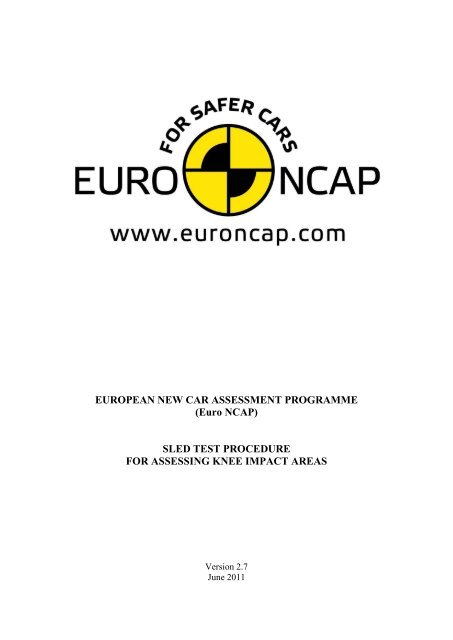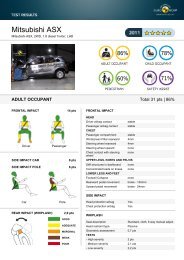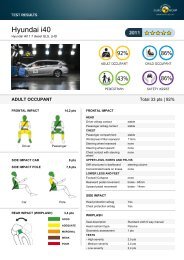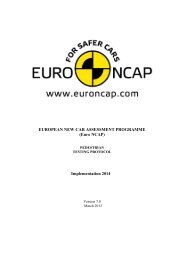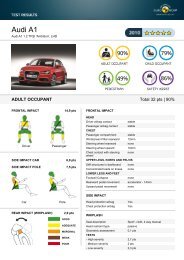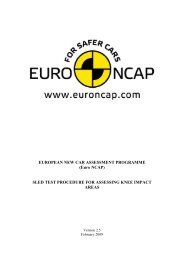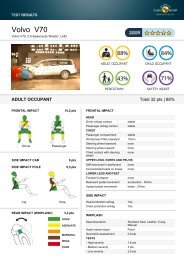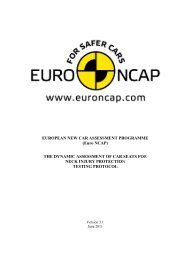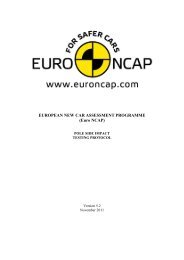SLED TEST - Euro NCAP
SLED TEST - Euro NCAP
SLED TEST - Euro NCAP
Create successful ePaper yourself
Turn your PDF publications into a flip-book with our unique Google optimized e-Paper software.
EUROPEAN NEW CAR ASSESSMENT PROGRAMME<br />
(<strong>Euro</strong> <strong>NCAP</strong>)<br />
<strong>SLED</strong> <strong>TEST</strong> PROCEDURE<br />
FOR ASSESSING KNEE IMPACT AREAS<br />
Version 2.7<br />
June 2011
Copyright ©<strong>Euro</strong> <strong>NCAP</strong> - This work is the intellectual property of <strong>Euro</strong> <strong>NCAP</strong>. Permission is granted<br />
for this material to be shared for non-commercial, educational purposes, provided that this copyright<br />
statement appears on the reproduced materials and notice is given that the copying is by permission<br />
of <strong>Euro</strong> <strong>NCAP</strong>. To disseminate otherwise or to republish requires written permission from <strong>Euro</strong> <strong>NCAP</strong>.<br />
Version 2.7<br />
June 2011
CONTENTS<br />
1 INTRODUCTION ............................................................................................. 1<br />
2 PREREQUISITES FOR KNEE MAPPING ...................................................... 2<br />
3 HARDWARE SETUP ....................................................................................... 3<br />
4 VALIDATION <strong>TEST</strong> ........................................................................................ 5<br />
5 MAIN <strong>TEST</strong> PROGRAMME............................................................................ 7<br />
6 PHOTOGRAPHIC RECORD ......................................................................... 11<br />
7 DATA PROCESSING AND REPORTING .................................................... 12<br />
8 KNEE AIRBAGS ............................................................................................ 12<br />
9 INTERACTION WITH EURO <strong>NCAP</strong> ............................................................ 14<br />
Appendix I ............................................................................................................... 15<br />
Version 2.7<br />
June 2011
1 INTRODUCTION<br />
1.1 Where knee airbags are fitted to a car, it is not possible to carry out an<br />
assessment of the knee contact zone in the normal way. Seat belt systems with<br />
devices such as double pretensioners may also make the conventional<br />
assessment, used by <strong>Euro</strong> <strong>NCAP</strong>, inappropriate. In other cases, the judgement<br />
may be marginal and manufacturers may wish to check potentially hazardous<br />
areas dynamically.<br />
1.2 A generic pulse, determined from a representative batch of LHD and RHD<br />
<strong>Euro</strong> <strong>NCAP</strong> ODB 64km/h tests, has been developed which can be used for any<br />
knee mapping tests, either on driver or front passenger seats. The<br />
corresponding acceleration and velocity change curves are attached in<br />
Appendix I.<br />
1.3 Where a manufacturer requests, <strong>Euro</strong> <strong>NCAP</strong> would accept a full series of knee<br />
mapping tests to be performed using the pulse from a full scale 64km/h ODB<br />
impact test instead of the generic pulse. ALL knee mapping tests must be done<br />
using the same pulse whether it be the generic or vehicle pulse.<br />
1.4 The manufacturer must demonstrate, for the areas in question, that femur loads<br />
are less than 3.8kN and knee slider values are less than 6mm in order to avoid<br />
knee modifiers. It should be noted that under normal circumstances, where the<br />
variable load modifier is not applied, the concentrated load modifier is also not<br />
applied.<br />
1.5 The <strong>Euro</strong> <strong>NCAP</strong> assessment for knee modifiers considers occupants of<br />
larger/smaller stature and weight than the 50th percentile Hybrid III used in<br />
the <strong>Euro</strong> <strong>NCAP</strong> full vehicle test. The use of the 95th percentile dummy for<br />
knee mapping ensures that a penetration deeper than that of the 50th percentile<br />
is achieved. Therefore, the full depth of the assessment zone (50th percentile<br />
penetration + 20mm) is covered by the test. Additionally, a 5 th percentile<br />
female dummy may be required to asses those areas where the 95 th dummy leg<br />
is unable to contact the hazards in the facia due to space restrictions.<br />
1.6 In normal circumstances, the tests can be conducted prior to the full vehicle<br />
test based on a Manufacturer’s assessment of the knee inspection zone.<br />
However, there is the possibility that not all hazards are identified beforehand<br />
and additional hazards may be highlighted for assessment in the inspection<br />
report.<br />
1.7 A validation test will be required by <strong>Euro</strong> <strong>NCAP</strong> if certain preconditions are<br />
not met (see Section 4.2) to ensure that the test configuration is fully<br />
representative of the full scale <strong>Euro</strong> <strong>NCAP</strong> test. Test houses should also be<br />
familiar with the <strong>Euro</strong> <strong>NCAP</strong> testing protocols, which are frequently<br />
referenced in this procedure. Details of the validation test requirements are in<br />
Section 4. The components used in the testing must be of the same design,<br />
specification, feature content and quality as those used in the official <strong>Euro</strong><br />
<strong>NCAP</strong> test.<br />
Version 2.7<br />
June 2011<br />
1
2 PREREQUISITES FOR KNEE MAPPING<br />
2.1 Vehicles that show large structural post test distortion are not eligible for knee<br />
mapping. Any of the following post test conditions disqualify the vehicle from<br />
knee mapping for any frontal occupants:<br />
Version 2.7<br />
June 2011<br />
Femur loads >3.8kN in the full vehicle test (driver or passenger)<br />
Knee Slider >6mm in the full vehicle test (driver or passenger)<br />
Vehicles that qualify for the application of a structural modifiers i.e.<br />
Integrity of the passenger compartment and/or footwell rupture<br />
Vehicles with A-pillar displacements above 65mm (using the standard<br />
<strong>Euro</strong> <strong>NCAP</strong> measurement)<br />
● Where any frontal impact restraining devices, such as airbags &<br />
pretensioners, deploy incorrectly, knee mapping data may not be accepted<br />
for that occupant<br />
2.2 It is the experience of the <strong>Euro</strong> <strong>NCAP</strong> secretariat that in cases where no<br />
additional knee protection technology (e.g. dual pretensioning, collapsible<br />
steering column design knee airbag or other suitable technology) is present,<br />
the knee mapping has been shown to not be successful. However, the presence<br />
of any particular technology to limit knee loads is not a pre-requisite for knee<br />
mapping.<br />
2
3 HARDWARE SETUP<br />
3.1 Sled facility<br />
3.1.1 An acceleration or deceleration based sled rig may be used. A “body in<br />
white” buck of the car model being assessed shall be mounted on the sled. All<br />
features which may influence knee impact protection must be installed in the<br />
body in white.<br />
3.2 Body preparation<br />
3.2.1 The bodyshell should be mounted on the sled such that there will be no<br />
permanent deformation of the body or its mounts, during the test programme.<br />
This is necessary to help ensure good repeatability. The pitch angle of the<br />
bodyshell should be set to 0 degrees, according to the manufacturer’s<br />
specification.<br />
3.2.2 The default yaw angle for the sled shall be 0 degrees. If the vehicle<br />
manufacturer can identify the need for a yaw angle other than 0 degrees in<br />
order to enable a stable contact with an identified hard point, this can be used<br />
throughout the main test program. In no cases, would <strong>Euro</strong> <strong>NCAP</strong> allow the<br />
yaw angle to be greater than 30 degrees.<br />
3.2.3 Parts can be removed from the body in white, provided that there is no<br />
question that their removal could influence the performance of the knee<br />
impact area. Any structural or inertial support of the knee impact area should<br />
be fully simulated. This would include the support given by the steering<br />
column or loads transmitted through it.<br />
3.2.4 The doors may be removed and the door aperture reinforced, to provide a clear<br />
view for the cameras. All components added to the bodyshell should be to the<br />
same specification as those used in the <strong>Euro</strong> <strong>NCAP</strong> frontal impact test. The<br />
restraint system and any active devices should be replaced for each individual<br />
test.<br />
3.2.5 Intrusion may occur which does not directly affect the knee impact area but<br />
which might provide additional support to structures supporting the knee<br />
impact area. These should be identified in the <strong>Euro</strong> <strong>NCAP</strong> inspection. For the<br />
sled tests, it may be acceptable for this type of intrusion to be simulated<br />
statically e.g. wooden spacers.<br />
3.3 Active restraints<br />
3.3.1 Any active components of restraint systems should be identical to those used<br />
in the <strong>Euro</strong> <strong>NCAP</strong> frontal impact test. However, it is acceptable for them to be<br />
triggered remotely to match the <strong>Euro</strong> <strong>NCAP</strong> frontal impact test firing times<br />
within ± 3ms. Where remote triggering is used, full details of the firing time,<br />
proportion of charge used and any other relevant details should be supplied,<br />
along with a comparison with relevant data from the <strong>Euro</strong> <strong>NCAP</strong> frontal<br />
impact test.<br />
Version 2.7<br />
June 2011<br />
3
Version 2.7<br />
June 2011<br />
4
4 VALIDATION <strong>TEST</strong><br />
4.1 Exemption from the validation test<br />
4.1.1 Where all of the following test conditions are met by the driver (only) in the<br />
nominated full scale test, a validation test is not required:<br />
Version 2.7<br />
June 2011<br />
A-Pillar displacement below 35mm (using the standard <strong>Euro</strong> <strong>NCAP</strong><br />
measurement)<br />
No significant seat, seat mounting or floor deformation that cannot be<br />
replicated in the main test program.<br />
Driver compressive femur loads below 1.0kN and passenger femur loads<br />
below 2.0kN.<br />
4.2 Sled Acceleration<br />
4.2.1 It needs to be demonstrated that the sled test sufficiently replicates a 64km/h<br />
ODB frontal impact of the subject vehicle. Therefore, the test can either be<br />
conducted with the pulse of the official <strong>Euro</strong><strong>NCAP</strong> crash test or a<br />
representative development test. The vehicle used in the representative full<br />
scale test should be similar to that intended for assessment in the official <strong>Euro</strong><br />
<strong>NCAP</strong> test in terms of engine, transmission and safety equipment. If the<br />
specification of vehicle for the official test is not known, or a different hand of<br />
drive is used, the manufacturer should provide data from a range of at least<br />
three different vehicle specifications. The manufacturer may then choose the<br />
representative test from the various examples provided and use it for the<br />
validation.<br />
4.2.2 The sled acceleration should be measured and compared with that measured,<br />
at the base of the impact side B-pillar, in the representative full scale test<br />
selected by the manufacturer.<br />
4.2.3 The suitability of the correlation between the vehicle and sled pulses will be<br />
checked according to the method detailed in Appendix I.<br />
4.3 Steering column adjustment<br />
4.3.1 The steering column shall be positioned the same as was the case in the <strong>Euro</strong><br />
<strong>NCAP</strong> frontal impact<br />
4.4 Dummy and instrumentation<br />
4.4.1 The validation test should be performed using the driver dummy only<br />
regardless of whether driver or passenger knee mapping is to be performed. A<br />
Hybrid III 50th percentile dummy shall be placed in the driver’s seat.<br />
4.4.2 The dummy shall be instrumented to the same level or greater to that specified<br />
for the <strong>Euro</strong> <strong>NCAP</strong> frontal impact test. Although the principal comparisons<br />
5
Version 2.7<br />
June 2011<br />
will be made using knee and femur responses, this additional data can aid<br />
understanding and explain any anomalies.<br />
4.5 Seat position<br />
4.5.1 The seat shall be positioned as in the <strong>Euro</strong> <strong>NCAP</strong> frontal impact test.<br />
4.6 Dummy positions<br />
4.6.1 The dummy shall be positioned as in the <strong>Euro</strong> <strong>NCAP</strong> frontal impact test, with<br />
extra care taken to ensure that the knee impact areas will be comparable.<br />
4.7 Performance criteria<br />
4.7.1 The knee impact locations and loads should be comparable to those occurring<br />
in the full scale test. To determine that this is so, the femur loads, the knee<br />
slider displacements and the damage to the facia will all need to be compared.<br />
Overall, the severity should be at least as severe as that in the representative<br />
test.<br />
4.7.2 In order to achieve the above, it might be necessary for the structural<br />
deformation to be simulated statically or, where sled test technology allows,<br />
dynamically. Furthermore, it might be necessary to introduce an alternative<br />
yaw angle of the body shell, see Section 3.2.<br />
6
5 MAIN <strong>TEST</strong> PROGRAMME<br />
5.1 Sled Acceleration<br />
5.1.1 The pulse performed on the sled facility should be at least as severe as the<br />
generic or the representative 64km/h ODB test pulse, whichever is used, and<br />
will be assessed according to the method detailed in Appendix I.<br />
5.2 Steering column adjustment<br />
5.2.1 The angular adjustment shall be positioned fully upwards with the axial<br />
adjustment in the mid position.<br />
5.3 Dummy and instrumentation<br />
5.3.1 A 95 th percentile male Hybrid III dummy shall normally be used. However,<br />
where it is not possible for the 95 th percentile knee to contact the hazard due to<br />
its size, the 5 th percentile female shall be used. The specific dummy to be used<br />
will be confirmed during the <strong>Euro</strong> <strong>NCAP</strong> inspection.<br />
5.3.2 Whichever stature of dummy is to be used, it shall be equipped with at least<br />
instrumentation to record femur axial force and knee slider displacement for<br />
both legs. Shoulder belt loads shall also be recorded to demonstrate that the<br />
pre-tensioning and load limiting characteristics of the restraint system are<br />
similar to those in the <strong>Euro</strong> <strong>NCAP</strong> frontal impact test.<br />
5.3.3 Additional instrumentation may be necessary in order to establish knee<br />
penetration.<br />
5.4 Driver seat position<br />
5.4.1 For 95 th percentile dummies, adjust the vehicle seat according to the procedure<br />
described in Section 6 of the <strong>Euro</strong> <strong>NCAP</strong> frontal crash test protocol.<br />
5.4.2 Use the procedure described under chapter 7.1 or 7.2 respectively of the<br />
frontal crash test protocol to determine the H-point.<br />
5.4.3 Then move the seat rearward by 30mm. If the seat has no locking position<br />
30mm reward choose the next notch forward.<br />
5.4.4 In the event that the dummy is installed in the vehicle and there is insufficient<br />
space between the knee and facia to position the knee in the desired area, then<br />
the H-point should be moved rearward to allow correct position. Should this<br />
be insufficient, the seat should be moved rearward until there is sufficient<br />
space up to the 95 th percentile seating position.<br />
Version 2.7<br />
June 2011<br />
7
5.4.5 For 5 th percentile dummies, the seat shall be positioned to the manufacturers<br />
5 th percentile seating position in the fore/aft direction. All other seat<br />
adjustments should be set to enable a stable knee contact with the target point.<br />
5.5 Driver dummy positioning<br />
5.5.1 The tolerances below detail the standard dummy position in the test<br />
programme. If the point cannot be contacted by the knee after following the<br />
steps detailed below, it may be necessary to deviate from one or all of these<br />
values. In particular, the foot position must be such that the correct knee<br />
impact area will be reached. Care should be taken that deviation from the<br />
original position is as small as possible.<br />
5.5.2 Initial H-point of the HIII 95th:<br />
The HIII 95th dummy H-point shall be within 13mm horizontally of a point<br />
30mm rearward of the H-point measured with the SAE J826 device during seat<br />
adjustment<br />
If the target H-point in the horizontal direction can not be achieved with the<br />
given seat position move the seat one notch in the appropriate direction and try to<br />
position the dummy again.<br />
5.5.3 Pelvic angle:<br />
The pelvic angle measurement gauge should read 22.5° ± 2.5° from the<br />
horizontal.<br />
5.5.4 Head:<br />
The transverse instrumentation platform of the head shall be within 2.5° of<br />
horizontal.<br />
5.5.5 Arms + Hands:<br />
For driver testing, place hands on the steering wheel in a similar fashion to that<br />
of the <strong>Euro</strong> <strong>NCAP</strong> test. However, minor adjustments on the arm and hand<br />
positions are allowed if this allows for better camera views of the knee impact<br />
area.<br />
For passenger testing, place the arms as in the <strong>Euro</strong> <strong>NCAP</strong> test setup.<br />
5.5.6 Torso:<br />
The torso should line up with the centre of the seat. However, the torso might<br />
have to be twisted to one side to allow for the knees to strike the points indicated<br />
in the <strong>Euro</strong> <strong>NCAP</strong> inspection. During twisting it is acceptable for the H-point<br />
location to change.<br />
5.5.7 Legs:<br />
The legs should initially be positioned according to the <strong>Euro</strong> <strong>NCAP</strong> frontal test<br />
protocol, but then their position shall be modified laterally so that the main load<br />
bearing knee will come into contact with the potential hard-point as indicated in<br />
the inspection report. The other knee shall be aimed at an area where it would be<br />
expected to receive experience little or no loading. Frequently, this would be<br />
achieved by positioning it laterally where it has the greatest spacing from the<br />
Version 2.7<br />
June 2011<br />
8
facia. The lateral position of the knees can be achieved with a variation of the<br />
knee spread and/or a twist of the torso.<br />
5.5.8 Feet:<br />
The feet should be placed as flat as possible on the toe board parallel to the<br />
centreline of the vehicle. If either of the feet comes into contact with a footrest or<br />
a wheel arch, place the foot fully onto that rest. It is permissible to adjust the foot<br />
position to ensure that the correct knee impact location can be obtained. In order<br />
to ensure a stable knee contact, it may also be necessary to prevent the relevant<br />
foot from moving forwards in the footwell.<br />
5.6 Passenger dummy positioning<br />
5.6.1 The minimum knee penetration required for all of the passenger femur load<br />
tests within main test programme is based on the limit of the inspection zone.<br />
This will be detailed in the inspection report and be based upon the penetration<br />
of the passenger knee obtained in the official <strong>Euro</strong> <strong>NCAP</strong> test including an<br />
additional 20mm.<br />
5.6.2 The passenger dummy positioning procedure will follow the procedure<br />
described in Sections 5.4 & 5.5. However, if this seating/dummy position does<br />
not achieve a minimum knee penetration equal to that of the limit of the<br />
inspection zone, the seat and dummy should be adjusted so that this limit is<br />
reached by the knee throughout the main test programme.<br />
5.6.3 The penetration of the passenger knee will be established using high speed<br />
video footage and/or pelvic displacement calculations. Alternative<br />
measurement methods for establishing pelvic displacement will also be<br />
accepted which can be shown to be of equal accuracy as using pelvis<br />
acceleration to establish knee penetration. If the position of the dummy is<br />
limited by the knees contacting the hazard and/or the amount of available seat<br />
travel, that most forward position should be used.<br />
5.6.4 Situations were potential hazards for knee slider are highlighted are treated<br />
equivalent to test for potential knee hazards. The dummy positioning<br />
procedure will follow the procedure described in Sections 5.4 & 5.5. However,<br />
if this seating/dummy position does not achieve a minimum knee displacement<br />
equal to that of the limit of the inspection zone (20mm), the seat and dummy<br />
should be adjusted so that this limit is reached. If knee slider is a concern it<br />
needs to be ensured that there is stable contact between the tibia and potential<br />
hazard. It may be necessary to make small adjustments to the angel of the<br />
Tibia to ensure contact with the correct location.<br />
5.7 Ensuring a stable knee contact to the potential hard point<br />
5.7.1 In order for a knee mapping sled test to be valid, it needs to be ensured that the<br />
main load bearing knee remains in stable contact with the potential hard point<br />
during the impact sequence. If the knee is deflected, the test will not be<br />
accepted as a valid measure of the potential hazard. It is important that the<br />
Version 2.7<br />
June 2011<br />
9
Version 2.7<br />
June 2011<br />
other knee is loaded as little as possible by either not contacting the facia or<br />
impacting the least supported area of the facia.<br />
5.7.2 In order to ensure this it is allowable for the knee spread to be artificially fixed<br />
(i.e. by the application of structural foam or similar, between the legs).<br />
Furthermore, it might be necessary to prevent the feet from moving forward<br />
during crash in order to prevent a dynamic drop of the knee during the impact<br />
sequence.<br />
5.7.3 If a stable contact can not be achieved with artificial knee spreading alone it is<br />
allowable to use an appropriate yaw angle of the sled other than 0 degrees to<br />
assess an individual hard point.<br />
5.7.4 In any case, it is essential to confirm the stable knee contact with the use of<br />
appropriate high speed camera footage.<br />
5.8 Dummy painting<br />
5.8.1 In the absence of acceptable camera evidence, paint or other suitable<br />
alternatives may be used in order to identify that the correct point has been<br />
contacted.<br />
5.9 Performance criteria<br />
5.9.1 In the <strong>Euro</strong> <strong>NCAP</strong> inspection, the potential hazards will be identified and it<br />
will be necessary for all of them to be fully explored in the test programme.<br />
5.9.2 The performance criteria used for the assessment will be femur forces below<br />
3.8kN and the knee slider responses shall be less than 6mm. No adjustment to<br />
the performance criteria is made for any change in dummy size.<br />
10
6 PHOTOGRAPHIC RECORD<br />
6.1 High speed film<br />
6.1.1 High speed film is required for ALL knee mapping testing including the<br />
validation test.<br />
6.1.2 Sled mounted high speed cameras should be used to record the whole of the<br />
relevant scene. This would include the seat, seat belt system, facia, steering<br />
column, door aperture and dummy trajectory from both left and right sides. It<br />
should record the knee impact location and provide verification that the knee<br />
was not deflected from the chosen location and that the feet remained stable<br />
on the toe board. This should include a camera view showing the knees and a<br />
camera view that shows the feet for the complete impact sequence. The high<br />
speed camera frame rate should be of the order of 1000 frames per second.<br />
6.2 Still photography<br />
6.2.1 In order for any knee mapping results to be accepted by <strong>Euro</strong> <strong>NCAP</strong>, it is<br />
essential that adequate photographic evidence of the test is provided by the<br />
manufacturer.<br />
6.2.2 Pre and post test still photography is required to clearly show the sled set-up<br />
and BIW construction. Still photographs should show the fixings of the body<br />
in white to the sled, in particular the steering column and facia mounting and<br />
the appropriate body reinforcements before and after the series of tests.<br />
Additionally, any structures added to simulate intrusion which could support<br />
the knee impact area should also be recorded.<br />
6.2.3 The structures present in the facia should be clearly visible to provide<br />
evidence that the sled set-up is representative of a production vehicle and that<br />
all required components have been included.<br />
6.2.4 It is essential that the position of the dummy and particularly its knees should<br />
be clearly shown, along with a photographic record of the paint applied to the<br />
knees. After each test, a record should be made of the knee contact area, any<br />
paint transfer marks, and any damage to any of the knee impact area<br />
components.<br />
6.2.5 Any broken, damaged or fatigued components should also be fully recorded<br />
using photographs. In some cases it will be necessary to remove these from the<br />
facia after the tests in order to provide the best view.<br />
6.3 Insufficient high speed or still photography could result in the knee mapping<br />
not being accepted by the <strong>Euro</strong> <strong>NCAP</strong> Secretariat.<br />
Version 2.7<br />
June 2011<br />
11
7 DATA PROCESSING AND REPORTING<br />
7.1 Data processing<br />
7.1.1 The test data should be sampled and filtered as specified in the <strong>Euro</strong> <strong>NCAP</strong><br />
frontal impact test protocol.<br />
7.2 Reporting<br />
7.2.1 Full information about the test set up should be supplied to <strong>Euro</strong> <strong>NCAP</strong>. This<br />
should include details of any work that has been done to compensate for<br />
supportive intrusion, how the steering column lower mass and attachments<br />
have been simulated and any special arrangements related to dummy<br />
positioning. Anything which could influence the assessment should be fully<br />
reported.<br />
7.2.2 For the validation test, a comparison should be provided to satisfy <strong>Euro</strong> <strong>NCAP</strong><br />
that the test set up and pulse is suitable for the assessment work.<br />
7.2.3 For the main test programme, the locations being investigated should be<br />
detailed and the outcome from each test should be given. In both cases, full<br />
data should be supplied, including graphical plots. A full explanation and<br />
comparative analysis should be supplied.<br />
8 KNEE AIRBAGS<br />
8.1 The test set-up and the assessment criteria described above are also applicable<br />
for vehicles with knee airbags. Knee mapping test data must be provided in<br />
order to avoid the variable load modifier. However, it is assumed that a<br />
properly deploying knee airbag substitutes the function of foam and load<br />
spreader in order to avoid the concentrated load modifier. The presence of a<br />
knee airbag will not automatically lead to the removal of the concentrated load<br />
modifier; knee mapping data will be required to prove the effectiveness of the<br />
system. The presence of a knee airbag will not automatically lead to the<br />
removal of the concentrated load modifier; knee mapping data will be required<br />
to prove the effectiveness of the system.<br />
8.2 Where the measured femur force is less than 3.8kN and the knee slider<br />
displacement is below 6mm, the variable contact and concentrated load<br />
modifiers will not be applied provided that, there is no bottoming out of the<br />
knee airbag.<br />
8.3 It must be clear that there is no risk associated with the presence of the airbag<br />
module or its support structures.<br />
8.4 Where a knee airbag does bottom out in the official ODB test, an additional<br />
sled test with the 50% percentile dummy in the ODB test seating position<br />
(setup as of validation test) is required with an airbag deployment time 10ms<br />
Version 2.7<br />
June 2011<br />
12
Version 2.7<br />
June 2011<br />
later than that used in the official ODB test. Where the femur loads or/and<br />
knee slider displacement exceed the acceptance criteria in Section 8.2, the<br />
variable load modifier will be applied.<br />
8.4.1 Bottoming out of the knee airbag will be identified from the femur traces<br />
using sharp increases in femur load of at least 1kN in 5ms, and an<br />
accompanying increase in pelvis acceleration. There may also be physical<br />
damage to any underlying structures and evidence from high speed film.<br />
8.4.2 If a knee airbag is deemed to have bottomed out in any of the tests and the<br />
femur loads and/or knee slider results exceed the acceptance criteria in Section<br />
8.2, the variable load modifier will be applied.<br />
13
9 INTERACTION WITH EURO <strong>NCAP</strong><br />
9.1 Any manufacturer who intends to present knee mapping test results to <strong>Euro</strong><br />
<strong>NCAP</strong> is required to advise the Secretariat when completing the vehicle<br />
matrix.<br />
9.2 Where additional <strong>Euro</strong> <strong>NCAP</strong> inspector or Secretariat time or resources are<br />
required to consider knee mapping data or to hold additional meetings, the<br />
costs will have to be funded by the manufacturer.<br />
Version 2.7<br />
June 2011<br />
14
Appendix I<br />
The pulse performed on the sled facility should be close to or more severe as the<br />
generic test pulse. To validate this point, the following process should be used:<br />
Change the orientation to have sled pulse and generic pulse in globally positive<br />
values<br />
Calculate by integration the Delta V from generic pulse DV1(t), setting the initial<br />
velocity to 0<br />
Calculate by integration the Delta V from sled test DV2(t), setting the initial<br />
velocity to 0<br />
Calculate the difference DV = DV1 – DV2<br />
Calculate by integration of DV1 the X displacement from generic pulse DX1(t),<br />
setting the initial value to 0<br />
Calculate by integration of DV2 the X displacement from sled test DX2(t), setting<br />
the initial value to 0<br />
Calculate the difference DX(t) = DX1(t) – DX2(t)<br />
Calculate DX at 120 ms<br />
Requirement #1:<br />
o If all the DV values up to 120 ms are in the zone as shown below,<br />
requirement #1 is OK – check requirement #2<br />
o If some DV values up to 120 ms are outside the zone, requirement #1 is not<br />
OK,<br />
sled test is less severe than the generic or ODB test<br />
pulse and cannot be accepted<br />
Version 2.7<br />
June 2011<br />
DV = DV(Generic or Vehicle Pulse) – DV(Sled)<br />
test)<br />
Not Accepted<br />
Not Accepted<br />
Accepted<br />
Sample pulse showing a sled test that cannot be accepted as parts of DV are outside<br />
the acceptable zone<br />
15
Requirement #2:<br />
o If DX value at 120 ms is negative, requirement #2 is OK<br />
sled test is accepted for knee mapping<br />
o If DX value at 120 ms is positive, requirement #2 is not OK<br />
sled test cannot be accepted<br />
Version 2.7<br />
June 2011<br />
DX = Integration(DV(Generic or Vehicle Pulse) – DV(Sled))dt<br />
Not Accepted<br />
Dx (t=120ms) < 0<br />
Accepted<br />
Dx (t=120ms) > 0<br />
Sample picture shows a sled test that cannot be accepted as DX is positive @ 120 ms<br />
16
Version 2.7<br />
June 2011<br />
17


